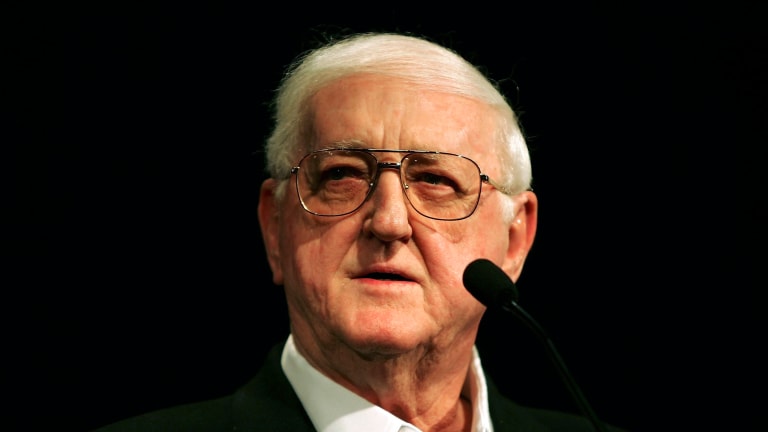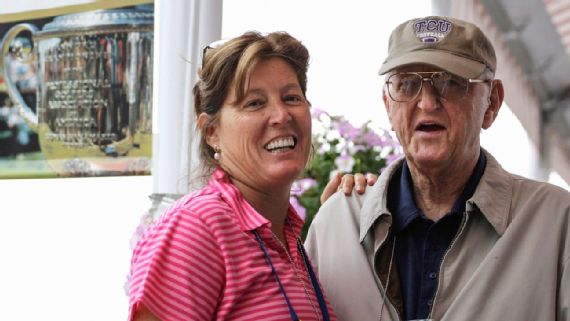I'll tell you one thing: Calling Dan Jenkins "a sportswriter" would be obscuring a higher truth. He was one of America's greatest living writers -- until he was no longer living.
Daniel Thomas Jenkins was born on December 2, 1928 in Fort Worth, Texas. He graduated from that city's R.L. Paschal High School, the former Fort Worth High School having been renamed for a former principal.
Other notable Paschal graduates include his former Fort Worth Press and Sports Illustrated teammate Bud Shrake, Yankee pitcher Jim Bronstad, former Oakland Athletics All-Star catcher and manager Jeff Newman, 1948 and '49 NFL Champion Philadelphia Eagles quarterback Tommy Thompson, 1964 NFL Champion Cleveland Browns quarterback and mathematician Dr. Frank Ryan, and a man who opened up to few people, but allowed Jenkins to become a close friend, golf icon Ben Hogan.
Also, Black Like Me author John Howard Griffin, gossip columnist Liz Smith, actor Norman Alden, music producer Joseph "T Bone" Burnett, Radio Shack founder Charles D. Tandy, Governors Price Daniel of Texas and Bill Owens of Colorado, and Apollo 12 Moonwalker Alan Bean. Actress-dancer Ginger Rogers attended, but dropped out.
Jenkins stayed in Fort Worth, and enrolled at Texas Christian University, where he played on the golf team. He wrote for the Fort Worth Press, then moved to the bigger city and worked for the Dallas Times Herald, before being hired by Sports Illustrated, for whom he wrote over 500 articles.
When SI celebrated its 60th Anniversary in 2014, they printed up a special edition, titled 60 Years, 60 Iconic Stories, with 60 of their greatest articles. And 4 of them were written by Dan Jenkins, including one for the October 17, 1966 edition, about Joe Namath, already the highest-paid and most flamboyant quarterback in pro football, but over 2 years away from his Super Bowl guarantee and win. Here is how Jenkins began the article:
Stoop-shouldered and sinisterly handsome, he slouches against the wall of the saloon, a filter cigarette in his teeth, collar open, perfectly happy and self-assured, gazing through the uneven darkness to sort out the winners from the losers. As the girls come by wearing their miniskirts, net stockings, big false eyelashes, long pressed hair and soulless expressions, he grins approvingly and says, "Hey, hold it, man—foxes." It is Joe Willie Namath at play. Relaxing. Nighttiming. The boss mover studying the defensive tendencies of New York's off-duty secretaries, stewardesses, dancers, nurses, bunnies, actresses, shopgirls—all of the people who make life stimulating for a bachelor who can throw one of the best passes in pro football. He poses a question for us all: Would you rather be young, single, rich, famous, talented, energetic and happy—or President?
Joe Willie Namath is not to be fully understood by most of us, of course. We are ancient, being over 23, and perhaps a bit arthritic, seeing as how we can't do the Duck. We aren't comfortably tuned in to the Mamas and the Uncles—or whatever their names are. We have cuffs on our trousers and, freakiest of all, we have pockets we can get our hands into. But Joe is not pleading to be understood. He is youth, success, the clothes, the car, the penthouse, the big town, the girls, the autographs and the games on Sundays. He simply is, man. The best we can do is catch a slight glimpse of him as he speeds by us in this life, and hope that he will in some way help prepare us for the day when we elect public officials who wear beanies and have term themes to write.
And he closed with:
If he stays healthy, Joe Willie may achieve his deepest ambition, which is "to become known as a good quarterback, not a rich one." He may even become what Boston Owner Billy Sullivan says he is now: "The biggest thing in New York since Babe Ruth." Slowly, because trying to fathom youth is always a slow process, you get the impression that Joe is quite serious about it and, despite his hip ways, is working hard to make it. Beneath the gaudy surface there somehow beams through a genuine, considerate, sincere, wonderfully friendly and likeable young man. But he's going to be himself. He's going to do it his way, and nobody else's.
For SI, he covered Michigan State vs. Notre Dame in 1966, USC vs. UCLA in 1967, Texas vs. Arkansas in 1969, and Nebraska vs. Oklahoma in 1971, all of them labeled "The Game of the Century." That's 4 Games of the Century in a span of just over 5 years. (His article on the '71 Huskers-Sooners game was another chosen for that 60th Anniversary tribute.)But he maintained that Texas was the true home of college football. It does often seem like a religion there, which makes the Cotton Bowl stadium in Dallas its Jerusalem (or its Mecca), Memorial Stadium in Austin its Vatican, and Texas vs. Texas A&M -- a rivalry not currently played in football, with the 1996 breakup of the old Southwest Conference putting the Longhorns in the Big 12 and the Aggies in the Southeastern Conference -- its holy war.
(Indeed, another article SI included in that special issue was from the Longhorns' 1963 National Championship season, under head coach Darrell Royal: "The Disciples of St. Darrell on a Wild Weekend.")
He wrote a book about college football titled Saturday's America. He wrote a book about college football in Texas, with a cover featuring Doak Walker, who starred at Southern Methodist University (SMU) in Dallas in the 1940s and the Detroit Lions in the 1950s, and is still regarded as the quintessential Lone Star State gridiron legend. It was titled I'll Tell You One Thing: The Untold Truth About Texas, America & College Football, With Pictures to Prove It. He wrote a book about sports in general, titled You Call It Sports, But I Say It's a Jungle Out There.
He also wrote a novel about pro football, Semi-Tough, a parody of both the NFL and one of the self-improvement crazes of the 1970s, Werner Erhard's "Erhard Seminars Training," or "est." (It was always spelled lower-case.) It was filmed in 1977. It wasn't the 1st time Burt Reynolds had played a quarterback, as he'd played Paul Crewe in The Longest Yard. It also starred Kris Kristofferson, Jill Clayburgh, Robert Preston, Lotte Lenya, Brian Dennehy, and Bert Convy as the Erhard analogue.
The football scenes were shot at the Cotton Bowl, although the team in the movie is based in Miami, near Reynolds' home. Like The Longest Yard, it used real football players, including Paul Hornung, Joe Kapp, Ed "Too Tall" Jones, and John Matuszak, a defensive end who won 2 Super Bowls with the Oakland Raiders. At one point, Matuszak is arguing with the team owner, played by Preston, over money, and says, "Every time I say it's a game, you say it's a business. Every time I say it's a business, you say it's a game!"
But his 1st love was golf. He wrote books titled Fairways and Greens, Jenkins at the Majors, Sports Illustrated's The Best 18 Golf Holes in America, The Dogged Victims of Inexorable Fate, and, with Curt Sampson, The Eternal Summer: Palmer, Nicklaus and Hogan in 1960, Golf's Golden Year.
(I don't have the book, so I don't know why Jenkins selected 1960 as "Golf's Golden Year." Maybe it was because it was the only time that the aging Hogan and the rising Jack Nicklaus, then just 20, were both among the leaders. Arnold Palmer, then the world's leading golfer, won the Masters, while Hogan, the top golfer of the late 1940s and early 1950s, finished 6th; Palmer beat Nicklaus by 2 strokes and Hogan by 4 in the U.S. Open; Australian golfer Ken Nagle beat Palmer by 1 stroke in the British Open; and Jay Hebert beat Palmer by 5 strokes in the PGA Championship.)
In 1989, in an SI column, Rick Reilly, then about to turn 30, had a list of things that the average American male sports fan should have done before turning 30. There were 53, and I ended up getting 37 done by the time I did. I did not count among them this one: "Own copies of Ball Four, The Boys of Summer, and The Dogged Victims of Inexorable Fate." To this day, I only own the first two of these, not the last, because it was one of Jenkins' books about golf, and I hate golf.
In 1984, as part of its College Football Preview Issue, SI did a feature on college football fans who had game streaks that would have caused a then 24-year-old Cal Ripken Jr. to choke on his crab cake. There was a 91-year-old woman who hadn't missed a Nebraska home game in 61 years. There was a married couple at historically black school North Carolina A&T who hadn't missed a home game since the husband came back from World War II. And there was Giles Pellerin, who had seen every USC game, home and away, since 1925, and would continue to do so until he died in 1998, a streak that would reach 797 games.
Jenkins' contribution to the story was about Paul Ridings, then the sports information director at both men's alma mater, TCU. He had been to 521 TCU games, home and away, including the last 381 in a row. Perhaps in recognition of making Ridings, however briefly, nationally famous, TCU named Jenkins the school's official historian. In 2017, they named the press box at their Amon G. Carter Stadium after him.
Jenkins retired from SI in 1985, and, aside from his monthly column in Golf Digest, stuck to books full-time. Larry King called him "the best sportswriter in America," and he was named to the Texas Sports Hall of Fame, the National Sportswriters and Sportscasters Hall of Fame, and the World Golf Hall of Fame.
He and his wife June had 3 children, sons Danny and Marty, and daughter Sally Jenkins, who also wrote for SI, and has now become an award-winning sports columnist for The Washington Post.
Sally and Dan, at the 2009 PGA Championship
Last year, in an interview, Dan Jenkins said, "I haven't done anything other than type and know people. I spent a lifetime, six or seven decades, not only typing for a living but cultivating sources."
He types and cultivates no more. Dan Jenkins died yesterday, March 7, 2019, at his home in Fort Worth, at the age of 90.
Ivan Maisel, once his fact-checker at SI, wrote this headline for ESPN.com's obituary: "A toast to Dan Jenkins, who humanized gods and changed sportswriting." Here is how Maisel began the article:
Dan Jenkins is gone, and everyone who loves college football, golf and the crisply struck one-liner will raise a glass. Preferably of J&B.
Meaning Justerini & Brooks, a brand of Scotch whiskey that Jenkins enjoyed. And he closed with:
I dropped him an email now and again, and he always answered within minutes. It's hard to swallow that I can't do that again. Instead, I'll swallow a J&B in his honor, and curl up with "Baja Oklahoma" for the 11th read.



No comments:
Post a Comment